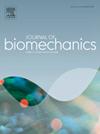A verification study on the accuracy of virtual thoracic endovascular aneurysm repair procedure
IF 2.4
3区 医学
Q3 BIOPHYSICS
引用次数: 0
Abstract
Computational models in the cardiovascular field, among which in Thoracic Endovascular Aneurysm Repair (TEVAR)—which involves the deployment of a stent-graft to exclude pathological region of the aorta from circulation—are gaining interest among clinicians as tools to support pre-operative decision-making. To assess the credibility of in-silico models, the American Society of Mechanical Engineers published the V&V40 framework, which includes verification, validation, and uncertainty quantification. This study presents a verification analysis of TEVAR simulations to evaluate the impact of selected parameters on simulation outcomes, focusing on specific quantities of interests.
Simulations were conducted on three patient-specific anatomies replicating the crimping, tracking, and release phases of the clinical procedure. Evaluated numerical parameters included mass damping, friction coefficient, tracking velocity, and release time. Sliding distance, rotation and computational time were analyzed in the tracking phase; while Opening Area, center-to-center distance, and plane rotation were evaluated in the release phase, comparing simulation results with post-operative CT segmentations.
A mass damping coefficient of 0.1 ms−1 for the stent-graft and 1 ms−1 for the catheter, a friction coefficient of 1 between stent-graft and catheter, and a velocity of 0.5 m/s yielded the best results during tracking. In the release phase, the selected parameters were: a damping of 0.1 ms−1, a friction coefficient of 0.1, and a release time of 5 ms.
In conclusion, this study provides a comprehensive analysis to support the selection of best settings for TEVAR simulations. A verification analysis is essential to understand the influence of numerical parameters on simulation outcomes.
虚拟胸腔血管内动脉瘤修复术准确性的验证研究
心血管领域的计算模型,其中包括胸腔血管内动脉瘤修复(TEVAR),它涉及到支架移植的部署,以排除主动脉的病理区域的循环,正在引起临床医生的兴趣,作为支持术前决策的工具。为了评估计算机模型的可信度,美国机械工程师协会发布了V&;V40框架,其中包括验证、确认和不确定性量化。本研究提出了TEVAR模拟的验证分析,以评估选定参数对模拟结果的影响,重点关注特定数量的利益。在三个患者特定解剖结构上进行了模拟,复制了临床程序的卷曲,跟踪和释放阶段。评估的数值参数包括质量阻尼、摩擦系数、跟踪速度和释放时间。分析了跟踪阶段的滑动距离、旋转和计算时间;在释放阶段评估开放面积、中心到中心距离和平面旋转,并将模拟结果与术后CT分割结果进行比较。当支架和导管的质量阻尼系数分别为0.1 ms - 1和1 ms - 1时,支架和导管之间的摩擦系数为1,速度为0.5 m/s时,跟踪效果最佳。在释放阶段,所选择的参数为:阻尼为0.1 ms−1,摩擦系数为0.1,释放时间为5 ms.总之,本研究为TEVAR模拟的最佳设置选择提供了全面的分析支持。验证分析对于理解数值参数对模拟结果的影响至关重要。
本文章由计算机程序翻译,如有差异,请以英文原文为准。
求助全文
约1分钟内获得全文
求助全文
来源期刊

Journal of biomechanics
生物-工程:生物医学
CiteScore
5.10
自引率
4.20%
发文量
345
审稿时长
1 months
期刊介绍:
The Journal of Biomechanics publishes reports of original and substantial findings using the principles of mechanics to explore biological problems. Analytical, as well as experimental papers may be submitted, and the journal accepts original articles, surveys and perspective articles (usually by Editorial invitation only), book reviews and letters to the Editor. The criteria for acceptance of manuscripts include excellence, novelty, significance, clarity, conciseness and interest to the readership.
Papers published in the journal may cover a wide range of topics in biomechanics, including, but not limited to:
-Fundamental Topics - Biomechanics of the musculoskeletal, cardiovascular, and respiratory systems, mechanics of hard and soft tissues, biofluid mechanics, mechanics of prostheses and implant-tissue interfaces, mechanics of cells.
-Cardiovascular and Respiratory Biomechanics - Mechanics of blood-flow, air-flow, mechanics of the soft tissues, flow-tissue or flow-prosthesis interactions.
-Cell Biomechanics - Biomechanic analyses of cells, membranes and sub-cellular structures; the relationship of the mechanical environment to cell and tissue response.
-Dental Biomechanics - Design and analysis of dental tissues and prostheses, mechanics of chewing.
-Functional Tissue Engineering - The role of biomechanical factors in engineered tissue replacements and regenerative medicine.
-Injury Biomechanics - Mechanics of impact and trauma, dynamics of man-machine interaction.
-Molecular Biomechanics - Mechanical analyses of biomolecules.
-Orthopedic Biomechanics - Mechanics of fracture and fracture fixation, mechanics of implants and implant fixation, mechanics of bones and joints, wear of natural and artificial joints.
-Rehabilitation Biomechanics - Analyses of gait, mechanics of prosthetics and orthotics.
-Sports Biomechanics - Mechanical analyses of sports performance.
 求助内容:
求助内容: 应助结果提醒方式:
应助结果提醒方式:


